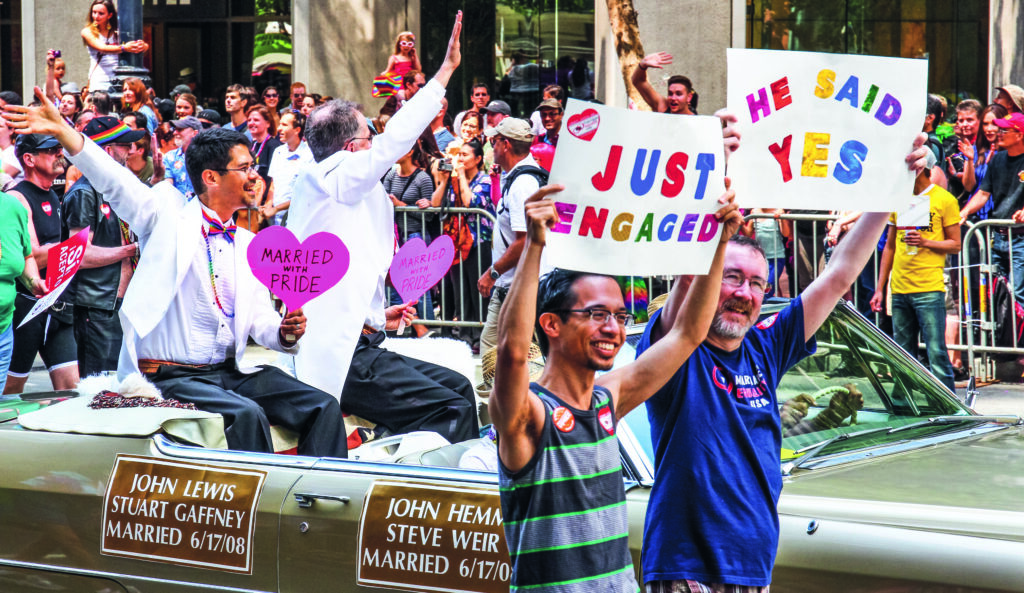New Book Celebrates the Heroes Who Fought for Marriage Equality in the U.S.
LOVE opens a beautifully illustrated window into history

Most people take for granted their ability to get married. But for LGBTQ+ couples in the United States, it’s a cherished right—obtained through years of struggle—that’s only existed nationwide for 10 years. LOVE: The Heroic Stories of Marriage Equality, a new book authored by Frankie Frankeny with journalist John Casey, presents the couples, activists and allies who fought to make it happen.
“The stories in this book span seven decades and show the extraordinary fierceness of our community,” Frankeny tells Muse. “They are not just reminders of why we fought for the 1,138 federal rights, privileges and protections that come with marriage. They are also a roadmap for what to do if we must defend them again.”
Here, Frankeny, a photographer, director and founder of Good Doxie Studios, talks about how LOVE, published by Rizzoli, came to be and why we can’t take our rights for granted.
MUSE: Tell me about your activism around marriage equality and how creativity factors in.
Frankie Frankeny: As a photographer, I understand the power of an image. Early on, my activism focused on capturing as many photographs as I could—images that, I felt, told a story in a single frame. Then, as we began assembling the book, I did my best to find visuals that could add a deeper layer to each story. We were fortunate to have more than a handful of people donate their images, believing in the power of this project and in the idea that our community deserves its heroes and history.

And how exactly did this book come to be?
I began documenting the marriage equality movement in 2004, when then–Mayor Gavin Newsom directed San Francisco to begin issuing marriage licenses to same-sex couples—an act that moved me deeply. Around the same time, Hillary and Julie Goodridge won the right to marry in Massachusetts. I was profoundly affected by the stories in both states and began to realize how vital they were. Over time, I noticed that while these stories existed, they were scattered across books, films, articles and television. I wanted to create a collection so people could see our community’s collective heroism in one place. The marriage equality movement didn’t happen overnight. It was built over decades of people coming out, telling their stories and fighting for a piece of the equality puzzle.
In an era where we consume so much online, I find it meaningful to have a book, a tangible object, full of these stories.
Thank you for that. I’ve received so much pushback over the past decade about producing a physical book, especially one this ambitious. It was incredibly expensive to create, and I hope, with the kindness of our community, we’ll eventually be able to cover those costs. But I’ve always loved books. As a culinary photographer, I’ve worked on over 80 of them. I wanted this one to be something people could flip through on their coffee tables instead of doomscrolling. Something that could spark meaningful conversations about our community, our heroes and our ongoing journey.
This project isn’t just about history. It’s also about now. The book goes through 2024, and our serialized podcast and docuseries continue the conversation. It’s a multimedia project. If you don’t have access to the book, you can listen to the stories in the podcast or subscribe to our global Substack, where people can also submit their own stories.
Every story in the book has meaning, but are there one or two that really stand out for you?
It was incredibly difficult to narrow these stories down to the ones that appear in the book. I hope our podcast will give us the opportunity to go even deeper and include many more stories that didn’t make it into the final pages. Each is triumphant in its own way.

One story I have carried in my heart for about four decades is Karen Thompson’s. Her partner, Sharon, became a quadriplegic after a devastating car accident. Sharon’s parents took custody, removed her engagement ring, forbade all contact between the two and placed her in a rest home. Karen fought for nearly a decade to bring Sharon home. I met Karen when she was touring the country, sharing her story on television and college campuses. She came to mine, and I never forgot her. Their story made major progress in partnership rights and disability rights. It taught our community about the critical importance of legal paperwork, especially at the height of the AIDS crisis.
Same-sex marriage is under attack, and my wife and I are worried about losing our rights, though we have been surprised to encounter a lot of people—all straight people—who confidently declare there is nothing to worry about! What do you say to people who insist there is nothing to fear?
Even some high-level leaders in the movement share that concern. After what happened with Roe v. Wade and Justice Clarence Thomas’ written opinion calling for the reconsideration of marriage equality and even Lawrence v. Texas, which essentially decriminalized being gay, it’s naïve to think it couldn’t happen. Of course, it’s possible, and even likely, that a new executive order or ruling could throw everything into chaos. That doesn’t mean the executive order would be legal. But it could still create fear, confusion and harm.



 Events
Events
